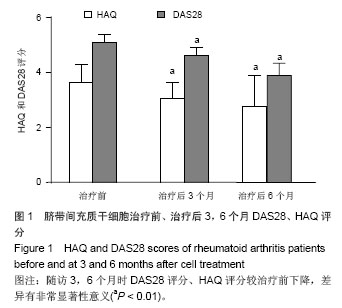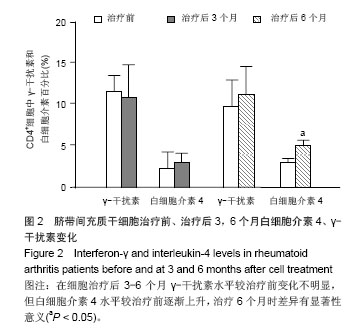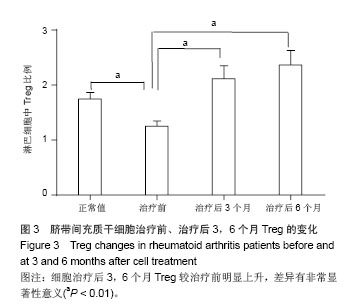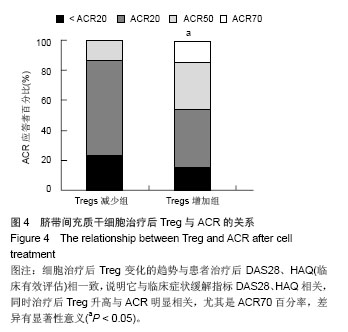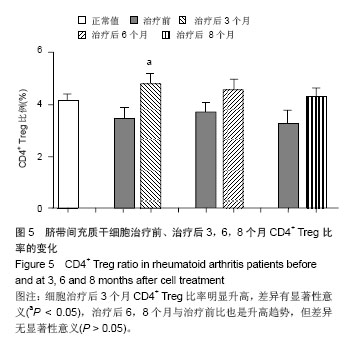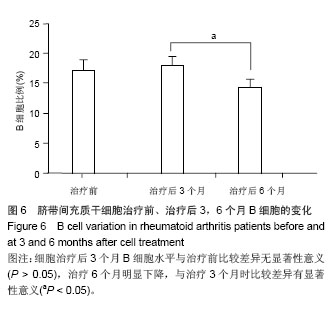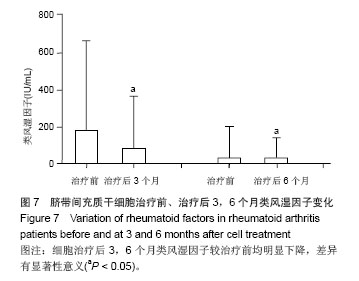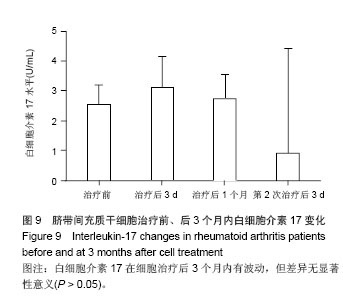中国组织工程研究 ›› 2014, Vol. 18 ›› Issue (45): 7279-7284.doi: 10.3969/j.issn.2095-4344.2014.45.012
• 干细胞移植 stem cell transplantation • 上一篇 下一篇
脐带间充质干细胞移植治疗类风湿性关节炎患者Th1/Th2、Treg的变化
王黎明1,王立华2,李 铭1,白 雯1,钟占强1,石 军1,周建军1,黄士高1,李 娜2,吉海杰2,刘拥军2,吴明远2
- 1解放军323医院,陕西省西安市 710054;2天津和泽干细胞转化再生医学研究中心,天津市 300381
Variation of Th1/Th2 and Terg in rheumatoid arthritis patients undergoing umbilical cord mesenchymal stem cell transplantation
Wang Li-ming1, Wang Li-hua2, Li Ming1, Bai Wen1, Zhong Zhan-qiang1, Shi Jun1, Zhou Jian-jun1, Huang Shi-gao1, Li Na2, Ji Hai-jie2, Liu Yong-jun2, Wu Ming-yuan2
- 1the 323rd Hospital of PLA, Xi’an 710054, Shaanxi Province, China; 2Heze Stem Cells and Regenerative Medicine Research Center, Tianjin 300381, China
摘要:
背景:类风湿性关节炎是自身免疫性疾病,传统治疗方法很难有效解决患者免疫耐受机制缺失的问题。随着干细胞再生医学的发展,应用干细胞治疗免疫性疾病成为热点。目前国内外对于细胞移植治疗类风湿性关节炎少有报道。
目的:探讨脐带间充质干细胞对类风湿性关节炎患者Th1/Th2、Treg变化的影响,为类风湿性关节炎寻找新的治疗方法。
方法:180例类风湿性关节炎患者,其中27例为对照组,给予非类固醇抗炎药和抗风湿药,153例为治疗组,静脉输注细胞数为4×107的脐带间充质干细胞40 mL,用药方案与对照组相同,76例患者在第1次细胞治疗的三四个月后接受了2次脐带间充质干细胞治疗。随访治疗后3,6个月进行临床有效性评估(DAS28、HAQ、ACR20)、类风湿因子、抗CCP抗体、T细胞亚群、Th细胞因子检测。部分2次细胞治疗患者随访至8个月检测Treg、T细胞亚群。
结果与结论: ①随访3个月时,细胞治疗组DAS28评分、HAQ评分、ACR20较对照组下降明显,差异有非常显著性意义(P < 0.01)。②脐带间充质干细胞治疗3,6个月的DAS28评分、HAQ评分较治疗前明显下降(P < 0.01),2次治疗较1次治疗继续下降(P < 0.01)。③治疗后3,6个月γ-干扰素水平较治疗前变化不明显,治疗后6个月白细胞介素4水平较治疗前逐渐上升(P < 0.05)。④治疗后3,6个月Treg较治疗前明显上升(P < 0.01),同时治疗后Treg升高与ACR明显相关,尤其是ACR70百分率(P < 0.05);治疗后3个月CD4+ Treg比率明显升高(P < 0.05),6,8个月时与治疗前相比也是升高趋势,但差异无显著性意义(P > 0.05)。⑤治疗后6个月B细胞水平明显下降(P < 0.05);治疗后3,6个月类风湿因子较治疗前均明显下降(P < 0.05)。⑥治疗后3,6个月抗CCP抗体和白细胞介素17水平变化不大。结果表明类风湿性关节炎患者给予脐带间充质干细胞治疗后Th1/Th2趋于平衡、Treg升高与临床实验指标及症状的缓解直接相关。因此按风湿病指南用药的同时,协同使用脐带间充质干细胞可改善类风湿性关节炎患者免疫网络效应、调整免疫耐受、改善病情。
中图分类号:

